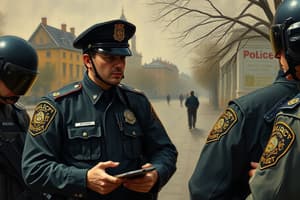Podcast
Questions and Answers
What is the primary purpose of this general order?
What is the primary purpose of this general order?
- To develop new forms for recording activity related to in-car audio/video
- To provide training for officers on in-car video systems
- To establish guidelines and procedures for the use of in-car video equipment (correct)
- To establish guidelines for the use of in-car audio equipment
What has been proven to assist in the prosecution of certain traffic and other offenses?
What has been proven to assist in the prosecution of certain traffic and other offenses?
- Physical evidence collected at the scene of an incident
- Independent video accounts of interactions between police and citizens
- Independent audio accounts of interactions between police and citizens
- Independent audio/video accounts of interactions between police and citizens (correct)
Why has in-car video equipment been used on numerous occasions?
Why has in-car video equipment been used on numerous occasions?
- To provide evidence for criminal cases
- To monitor officer performance and behavior
- To record traffic violations
- To protect an officer from fraudulent accusations of misconduct brought by citizens (correct)
Who is responsible for issuing, maintaining, and repairing all in-car video systems?
Who is responsible for issuing, maintaining, and repairing all in-car video systems?
What is the purpose of the In-Car Video Tracking Log?
What is the purpose of the In-Car Video Tracking Log?
What form is used when copies of recordings for case preparation are submitted to the State Attorney's Office or other agency/person with a legitimate request?
What form is used when copies of recordings for case preparation are submitted to the State Attorney's Office or other agency/person with a legitimate request?
What is the purpose of the Escambia County Sheriff's Office furnishing and maintaining in-car audio and video systems within each marked patrol vehicle?
What is the purpose of the Escambia County Sheriff's Office furnishing and maintaining in-car audio and video systems within each marked patrol vehicle?
Who will utilize the in-car audio/video equipment as outlined in this order?
Who will utilize the in-car audio/video equipment as outlined in this order?
What is the primary responsibility of officers regarding equipment readiness?
What is the primary responsibility of officers regarding equipment readiness?
Who does the Video System Evidence Coordinator (VSEC) report to?
Who does the Video System Evidence Coordinator (VSEC) report to?
When must officers activate their video cameras?
When must officers activate their video cameras?
What is the responsibility of the Fleet Maintenance Section in regards to the in-car video system?
What is the responsibility of the Fleet Maintenance Section in regards to the in-car video system?
What is an example of a discretionary use of the video system?
What is an example of a discretionary use of the video system?
What is the purpose of the scheduled replacement of in-car video systems?
What is the purpose of the scheduled replacement of in-car video systems?
Who is responsible for ensuring that their issued equipment is in operational condition at all times?
Who is responsible for ensuring that their issued equipment is in operational condition at all times?
What must officers do when they exit the vehicle?
What must officers do when they exit the vehicle?
Why might an officer deactivate the audio recording?
Why might an officer deactivate the audio recording?
What should an officer do if they encounter a problem with their in-car video system?
What should an officer do if they encounter a problem with their in-car video system?
What is the purpose of labeling recordable media?
What is the purpose of labeling recordable media?
What is the role of the Recordable Media Custodian?
What is the role of the Recordable Media Custodian?
What is an example of a law enforcement function that requires system activation?
What is an example of a law enforcement function that requires system activation?
Why is it important for officers to maintain custody of issued recordable media?
Why is it important for officers to maintain custody of issued recordable media?
Why must officers use only the equipment assigned to them?
Why must officers use only the equipment assigned to them?
What should an officer do if the equipment cannot be repaired?
What should an officer do if the equipment cannot be repaired?
What is the purpose of monitoring crime scenes?
What is the purpose of monitoring crime scenes?
What is prohibited by the assigned officer in regards to equipment repair?
What is prohibited by the assigned officer in regards to equipment repair?
What must officers avoid making during recording?
What must officers avoid making during recording?
What is the purpose of the Video System Evidence Coordinator (VSEC) in the program?
What is the purpose of the Video System Evidence Coordinator (VSEC) in the program?
Who is responsible for securely storing recordable media separately by type?
Who is responsible for securely storing recordable media separately by type?
What is the minimum duration for retaining non-evidentiary media?
What is the minimum duration for retaining non-evidentiary media?
Who can request copies of recordable media for training purposes?
Who can request copies of recordable media for training purposes?
What is the purpose of tagging a video clip with a complaint number?
What is the purpose of tagging a video clip with a complaint number?
What information must be included in requests for copying of recordable media?
What information must be included in requests for copying of recordable media?
What should an officer do when a recorded event becomes evidentiary?
What should an officer do when a recorded event becomes evidentiary?
When can an officer view the contents of a recorded incident?
When can an officer view the contents of a recorded incident?
What is part of the training for in-car audio/video recording systems?
What is part of the training for in-car audio/video recording systems?
How long should non-evidentiary recorded media be held before destruction?
How long should non-evidentiary recorded media be held before destruction?
What should an officer do when an event is captured by multiple in-car systems?
What should an officer do when an event is captured by multiple in-car systems?
Who is responsible for logging all recordable media turned into the Evidence Room?
Who is responsible for logging all recordable media turned into the Evidence Room?
Why might an officer reset the date/time stamp function on a recording?
Why might an officer reset the date/time stamp function on a recording?
What happens to evidentiary media after verification that it is no longer needed as evidence?
What happens to evidentiary media after verification that it is no longer needed as evidence?
What is prohibited regarding agency equipment and recorded media?
What is prohibited regarding agency equipment and recorded media?
Who can request a release from the submitting officer?
Who can request a release from the submitting officer?
What is documented in offense reports and call histories?
What is documented in offense reports and call histories?
What should an officer do with a recorded event that captures a critical incident?
What should an officer do with a recorded event that captures a critical incident?
When should an officer replace a recorded media?
When should an officer replace a recorded media?
What is the purpose of the 'Keep Online' tab in the auto-downloading system?
What is the purpose of the 'Keep Online' tab in the auto-downloading system?
What will the officer do if the Media Track Program is not operational?
What will the officer do if the Media Track Program is not operational?
What is the complaint number format for video clips?
What is the complaint number format for video clips?
Where should the recordable media identification label be affixed for non-evidentiary recordings?
Where should the recordable media identification label be affixed for non-evidentiary recordings?
What information should be included on the recordable media identification label for evidentiary recordings?
What information should be included on the recordable media identification label for evidentiary recordings?
Who reviews the recordable media with possible evidentiary value prior to submitting it to evidence?
Who reviews the recordable media with possible evidentiary value prior to submitting it to evidence?
What should the officer circle on the media label for DUI incidents?
What should the officer circle on the media label for DUI incidents?
What is the purpose of the officer completing the evidence card?
What is the purpose of the officer completing the evidence card?
What should the officer do with non-evidentiary recordings after affixing the identification label?
What should the officer do with non-evidentiary recordings after affixing the identification label?
Why is a supervisor's review of recordable media with possible evidentiary value necessary?
Why is a supervisor's review of recordable media with possible evidentiary value necessary?
Flashcards are hidden until you start studying
Study Notes
In-Car Video Equipment Policy
- Purpose: Establish guidelines for the use of in-car video equipment to assist in prosecution of traffic and other offenses, and to protect officers from fraudulent accusations of misconduct.
Procedures
- Forms:
- In-Car Video Tracking Log: Records information related to recorded events, subsequent actions, and recordable media.
- Transfer Receipt for Recordable Media: Used for submitting copies of recordings for case preparation.
Program Procedures
- Camera and Equipment Responsibilities:
- Video System Evidence Coordinator (VSEC) is responsible for program coordination, issuing equipment, and maintenance.
- Fleet Maintenance Section is responsible for log tracking, maintenance, and repair of equipment.
Scheduled Replacement
- Equipment replacement schedule every 3-5 years, depending on condition and life expectancy.
Recordable Media Management
- Evidence Unit is responsible for recordable media management, including distribution, collection, maintenance, categorization, storage, and copying.
Officer Responsibilities
- Ensure equipment is in operational condition at all times.
- Check out recordable media from the Recordable Media Custodian.
- Update the Media Track System when installing or removing recordable media.
- Maintain custody of issued recordable media.
- Report any defects or usage problems to the supervisor and Fleet Services Section.
Camera/Equipment Usage
- Officers are responsible for ensuring their systems are functioning at the beginning of each tour of duty.
- Equipment is to be used as trained, in accordance with manufacturer’s instructions, and according to this order.
Recording Handling, Usage, and Disposition
- Officers will only use recordable media provided by the agency.
- Recordable media will be submitted in their original cases/sleeves, labeled with start date/time, and chapter number.
- Evidentiary recorded media will be noted on the media label and evidence card.
Prohibited Acts
- Officers are prohibited from:
- Using agency equipment for non-work-related purposes.
- Defeating or overriding the automatic activation feature.
- Disabling the system during recording.
- Recording over or erasing previously recorded segments.
- Altering the date/time stamp function.
Media Storage/Retrieval/Copying
- Media control, categorization, and storage are the responsibility of the recorded media custodian.
- Evidentiary media will be retained and securely stored separately from non-evidentiary media.
Requesting Copies/Viewing of Recordings
- All requests for copying of recordable media must be made in writing by the requesting authority.
- Copies will be made for specified cases upon request by Internal Affairs investigators, Investigations OIC, and/or State’s Attorney’s Office personnel.
Documenting Recorded Incidents
- Recordings, system usage, and activities will be documented in offense reports and call histories.
- Officers will note in any related offense/arrest/incident reports that an incident has been recorded, including the recordable media number.
Training
- All users and assignees of in-car audio/video recording systems will receive training on:
- Proper operation of the in-car video equipment.
- Uses of the equipment.
- Video techniques.
- Current case law concerning video and audio recording of suspects.
- Proper handling and storage of recordings.
Studying That Suits You
Use AI to generate personalized quizzes and flashcards to suit your learning preferences.




